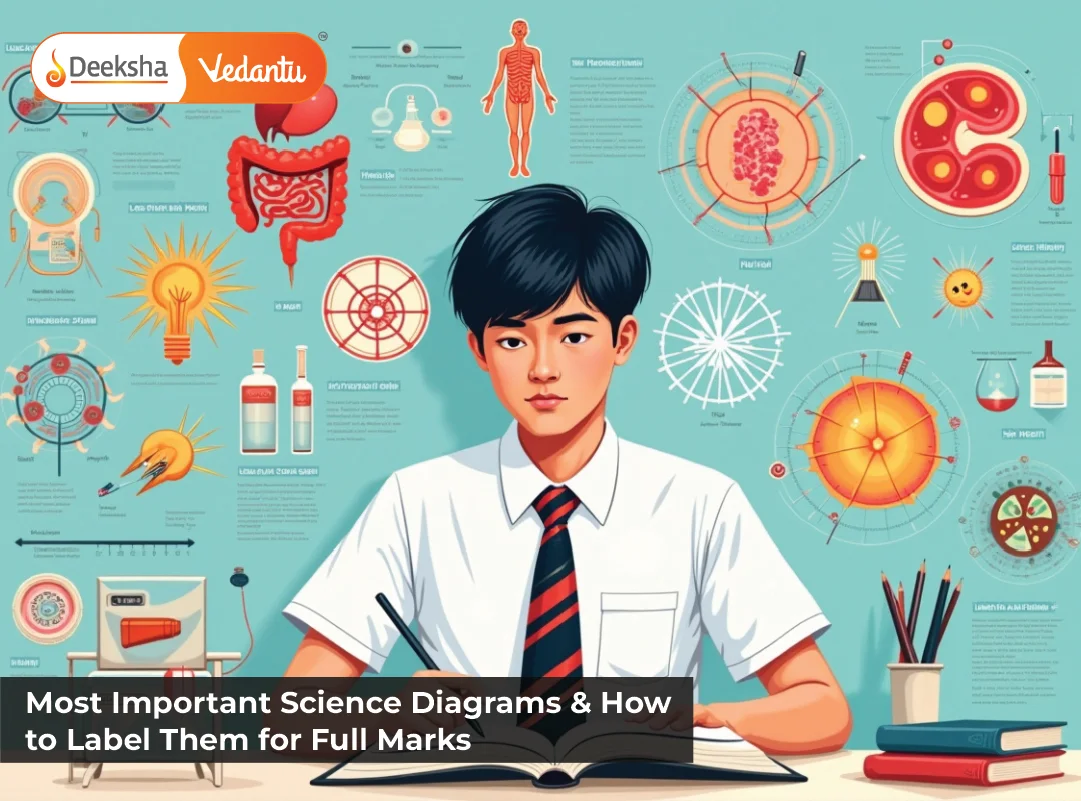Introduction
Science diagrams play a crucial role in scoring well in the Karnataka SSLC 2025 exams. Whether it’s biology, physics, or chemistry, well-drawn and accurately labeled diagrams can help you secure easy marks — often with minimal writing. Examiners look for neatness, correct proportion, and proper labeling, and many students lose marks due to careless mistakes. With regular practice and the right techniques, you can master diagram-drawing and make it one of your strongest scoring areas. At Deeksha Vedantu, students are trained through structured diagram practice sessions to ensure they don’t just memorize but understand how to draw and label with clarity and confidence.
Why Science Diagrams Are Important in SSLC Exams
In SSLC science exams, diagrams are more than just illustrations — they are part of the question paper itself and often carry direct marks. Even if you’re short on time or struggling to write long answers, presenting a neat and correctly labeled diagram can help you secure full or partial marks.
1. How Diagrams Help Secure Easy Marks
A diagram with proper labeling often fetches full marks if it’s neat and accurate. Examiners appreciate visual representation because it shows concept clarity.
2. Examiners’ Expectations from Diagrams
Examiners look for clean lines, correct proportions, proper arrow placements, and clear labels written on one side with straight lines pointing to the parts. Overlapping lines, scribbles, or poorly spaced diagrams can reduce your marks.
3. Importance of Neatness, Accuracy, and Proper Labeling
A diagram’s effectiveness is not just in drawing it but in presenting it. Neat, sharp diagrams with proper labeling make your paper look organized and create a positive impression. At Deeksha Vedantu, students are trained to follow stepwise presentation techniques that match examiner expectations.
Key Tips for Drawing and Labeling Science Diagrams
Drawing diagrams correctly and labeling them neatly can help you earn full marks with minimal effort. Follow these simple but powerful tips to ensure your diagrams are examiner-friendly:
1. Use a Pencil and Ruler for Neatness
Always draw diagrams with a sharp pencil and use a ruler for straight lines. Avoid pens or colored pencils unless specifically mentioned. A clean, pencil-drawn diagram looks professional and can be easily corrected if needed.
2. Draw Clean, Proportionate Diagrams
Make sure your diagrams are neither too large nor too small. They should fit well on the page with enough space for labels. Maintain symmetry and proportion, especially in diagrams of human organs, flowers, or physics setups.
3. Label on the Right-Hand Side with Straight Lines
Labels should always be written neatly on the right-hand side of the diagram. Draw straight, horizontal lines from each part to its label. Avoid crossing lines or writing labels inside the diagram. This makes the diagram look well-organized and easy to check.
4. Underline Headings of Diagrams
Before drawing the diagram, write the title (for example, “Structure of Human Heart”) and underline it. This helps the evaluator immediately understand what the diagram represents and keeps your answer sheet structured.
5. Practice Frequently to Improve Speed and Accuracy
Even if you know how to draw a diagram, practice it multiple times before the exam. This helps improve muscle memory, reduces drawing time, and ensures you won’t struggle with proportions or labeling in the exam hall. At Deeksha Vedantu, students are given dedicated practice worksheets and timed diagram drills to help them perfect their technique.
Most Important Biology Diagrams for SSLC 2025
Biology diagrams are often considered scoring questions in the SSLC exams because they require less writing and focus on visual accuracy. A neat diagram with proper labeling can fetch you full marks, even if your theoretical explanation is brief. Below are the most important biology diagrams you must practice regularly, along with key tips on how to present them:
1. Human Digestive System
- Draw a well-proportioned diagram showing the mouth, esophagus, stomach, liver, pancreas, small intestine, and large intestine.
- Make sure the intestines are neatly coiled and not overlapping.
- Labels should be placed on the right-hand side, with straight lines drawn using a ruler.
- Use arrows to show the direction of food movement if asked.
- Exam Tip: Underline the title and mention ‘Well-labeled diagram of the human digestive system’ before starting.
2. Human Respiratory System
- Start with the nasal cavity, trachea, bronchi, lungs, and diaphragm.
- The trachea should split into two bronchi connecting to both lungs.
- The lungs should be symmetrical, with alveoli clusters shown (if required).
- Use arrows to indicate airflow direction.
- Exam Tip: If time permits, show the rib cage outline for added clarity.
3. Human Heart
- Practice symmetrical representation of atria (upper chambers), ventricles (lower chambers), pulmonary artery, pulmonary vein, aorta, and vena cava.
- Mark the flow of oxygenated and deoxygenated blood with arrows.
- Label left and right chambers accurately — remember they appear opposite from the viewer’s side.
- Presentation Tip: Draw medium-sized; avoid overly large diagrams that look clumsy.
4. Human Brain
- The cerebrum should be large with curved lines indicating folds.
- Add cerebellum, medulla oblongata, and spinal cord.
- Label left and right cerebral hemispheres if asked.
- Use proper proportions to avoid distorted shapes.
- Tip: Keep lines light and neat; dark outlines can make the diagram messy.
5. Structure of a Neuron
- Start from the dendrites, progressing to the cell body, nucleus, axon, and synaptic terminal.
- Add arrow marks showing impulse direction.
- Labels should not crowd the structure; maintain spacing.
- Tip: Practice drawing neurons quickly; it’s often asked for labeling-based questions.
6. Female Reproductive System
- Ensure symmetry: Draw the uterus in the center with fallopian tubes extending to both ovaries.
- Label uterus, ovary, fallopian tube, vagina, and cervix.
- Use clean, curved lines; avoid sharp angles.
- Exam Tip: This diagram is often repeated in question papers — practice it thoroughly.
7. Plant Cell and Animal Cell
- Draw both side by side if asked to compare.
- Include nucleus, cell wall (in plant cell), mitochondria, chloroplasts (in plant cell), Golgi apparatus, and endoplasmic reticulum.
- Label organelles inside the cell clearly with arrows extending outside the diagram.
- Presentation Tip: Keep plant and animal cell diagrams distinct; show rectangular shape for plant cell and oval for animal cell.
8. Structure of a Flower
- Draw a large flower showing petals, sepals, stamen (with anther and filament), and carpel (with stigma, style, ovary).
- Use proper petal arrangement for realism.
- Label each part on one side with clean, straight lines
- Tip: Practice both longitudinal and transverse sections if your textbook has both formats.
9. Germination of Seed
- Draw stages of germination (seed, radicle emergence, plumule growth).
- Arrows indicating stages help show progression.
- Label radicle, plumule, cotyledon, and seed coat.
- Exam Tip: Practice this diagram as a sequence chart to show clear stages.
Most Important Physics Diagrams for SSLC 2025
Physics diagrams are not only important for visual representation but also play a key role in scoring marks in questions related to optics, electricity, and magnetism. Examiners give step marks for correct ray paths, arrows, labeling, and clarity of lines. Here are the most important physics diagrams you need to practice for the SSLC 2025 exams, along with tips to draw and label them perfectly:
1. Ray Diagrams of Concave and Convex Lenses
- Practice drawing diagrams for:
- Object at infinity
- Object beyond 2F
- Object between F and 2F
- Object at F and between lens and F
- Mark principal axis, focus (F), and center of curvature (2F).
- Draw clean straight lines with arrows indicating the direction of rays.
- Label focus, object, image, and lens clearly.
- Exam Tip: Keep lines thin and avoid over-shading; maintain symmetry on both sides of the principal axis.
2. Ray Diagrams of Concave and Convex Mirrors
- Practice object placement at various positions (at infinity, beyond C, between C & F, at F, between F & P).
- Label pole (P), center of curvature (C), focus (F), object, and image positions.
- Draw reflected rays with proper arrow direction and intersection points for image formation.
3. Electric Circuit Diagram (Series and Parallel Connection)
- Include battery cells, resistors (with standard zigzag symbol), ammeter, voltmeter, switches, and connecting wires.
- Label each component below or next to the symbol.
- Arrows showing current direction are important for clarity.
- Presentation Tip: Keep circuit diagrams neat, with components evenly spaced. Deeksha Vedantu trains students in standardized circuit diagram drawing using textbook symbols.
4. Magnetic Field Lines Around a Bar Magnet
- Draw a horizontal bar magnet with poles labeled (N and S).
- Use curved lines showing field lines emerging from the north pole and entering the south pole.
- Add arrows to indicate field line direction.
- Show lines closer near poles (indicating stronger fields) and spaced out away from the poles.
5. AC and DC Generator Diagrams
- Include armature coil, brushes, split or slip rings, and magnetic field lines.
- Label all parts: coil, commutator, brushes, axis, magnetic poles.
- Use arrows for coil rotation and induced current direction.
- Tip: Practice both AC and DC generator diagrams multiple times; these are frequently asked 3- or 4-mark questions.
6. Electromagnetic Induction Setup
- Draw a coil connected to a galvanometer, and a bar magnet being pushed or pulled towards the coil.
- Use arrows to show magnet movement and induced current direction.
- Label coil, galvanometer, north and south poles of the magnet.
Most Important Chemistry Diagrams for SSLC 2025
Chemistry diagrams are commonly asked in experimental setups and structural representations. A neat diagram with correct labeling can easily fetch full marks. Since chemistry questions often test application and understanding, presenting accurate diagrams shows conceptual clarity. Here are the key chemistry diagrams to focus on for the SSLC 2025 exams:
1. Arrangement of Electrons in Shells (Bohr’s Model)
- Draw the nucleus in the center with protons and neutrons indicated.
- Show electron shells (K, L, M) as concentric circles.
- Mark electrons on each shell with dots or small circles.
- Label shells and number of electrons per shell.
- Tip: Practice diagrams for elements like Hydrogen, Helium, Carbon, and Neon, as these are frequently asked.
2. Experimental Setup for Electrolysis of Water
- Draw two electrodes immersed in water with a battery connected.
- Show gas collection tubes and arrows indicating hydrogen and oxygen gas release.
- Label cathode (negative electrode) and anode (positive electrode).
- Label H₂ and O₂ collection areas with proper proportions (twice the hydrogen volume compared to oxygen).
3. Heating of Ammonium Chloride (Sublimation Setup)
- Draw a glass funnel placed on a china dish containing ammonium chloride, covered with cotton.
- Show heat being applied below the dish.
- Mark the deposition of ammonium chloride on the funnel walls.
- Label all apparatus (funnel, china dish, ammonium chloride, heat source).
4. Distillation Apparatus
- Draw a round-bottom flask connected to a condenser tube and a receiver flask.
- Show the heat source below the flask and vapor movement into the condenser.
- Add arrows for the direction of vapor flow and condensation.
- Label the flask, condenser, thermometer, water inlet and outlet, and collection vessel.
- Tip: Practice this diagram multiple times; it’s a common question in separation technique-based questions.
5. Chemical Apparatus Setup for Preparation of Hydrogen Gas
- Draw a conical flask containing dilute acid and zinc granules, connected via a delivery tube to a gas-collecting jar.
- Include a thistle funnel for adding acid.
- Show water displacement in the gas jar for hydrogen collection.
- Label flask, delivery tube, gas jar, acid, and zinc.
- Presentation Tip: Neat lines, clear labeling, and proportionate apparatus size make a positive impact on examiners.
Common Mistakes to Avoid While Drawing Diagrams
Even well-prepared students sometimes lose easy marks due to avoidable mistakes in diagrams. By understanding these common errors, you can ensure your diagrams are always neat, clear, and exam-ready.
1. Drawing Freehand Lines That Are Messy
Avoid drawing diagrams without using a pencil and ruler (especially in physics and chemistry setups). Wavy or uneven lines make the diagram look untidy and can cost marks. Clean, straight lines create a professional and clear presentation.
2. Missing Arrows or Improper Direction Indicators
Arrows are crucial in diagrams like ray diagrams, magnetic fields, electric circuits, and gas collection setups. Forgetting to draw or misplacing arrows can mislead the examiner and lead to partial marking. Always double-check arrow directions.
3. Incomplete Labeling or Crowded Labels
Leaving out labels or writing labels inside the diagram makes it difficult for the examiner to assess your diagram. Make sure all parts are labeled on the right-hand side with neat straight lines. Avoid clutter and ensure each label is placed with adequate spacing.
4. Incorrect Proportions
Disproportionate organs (in biology) or uneven apparatus sizing (in chemistry diagrams) make the diagram look inaccurate. Practice multiple times to ensure correct sizing and symmetry.
5. Overlapping Lines and Unclear Structures
In diagrams like the human heart, digestive system, or brain, avoid overlapping lines. If parts cross each other without clarity, the diagram looks confusing and could lead to deductions.
6. Not Underlining the Diagram Heading
Always underline the title of your diagram (e.g., “Diagram of Human Digestive System”) before drawing. This helps the examiner identify what you’re drawing quickly and adds to presentation quality.
How Deeksha Vedantu Helps Students Perfect Their Diagram Practice
At Deeksha Vedantu, we understand that diagrams are not just an additional part of science answers — they are often the easiest way to secure full marks. That’s why diagram practice is given special focus in our teaching methodology. Here’s how Deeksha Vedantu helps students master the art of drawing and labeling diagrams confidently:
1. Dedicated Diagram Practice Sessions
Our classroom schedules include regular, focused diagram practice where students are taught step-by-step how to draw important diagrams from each chapter. Repeated practice builds muscle memory and reduces hesitation during exams.
2. Visual Learning Aids and Templates
Deeksha Vedantu provides clear visual templates and printed guides showing the ideal size, structure, and proportion of each diagram. These reference sheets help students replicate diagrams accurately when needed.
3. Labeling Technique Workshops
Students are trained on how to place labels neatly, use proper arrows, and maintain line clarity. Label placement exercises are conducted to ensure that no diagrams are left incomplete or cluttered in the exam.
4. Regular Diagram-Based Tests
Periodic diagram-based assessments test students on speed and accuracy. These tests simulate exam conditions and help students improve their ability to draw and label diagrams under pressure.
5. Instant Feedback and Corrections
Teachers at Deeksha Vedantu provide immediate feedback on diagram quality, pointing out mistakes in proportion, structure, or labeling and helping students correct them on the spot.
6. Diagram Recap Before Exams
Before exams, students are given quick-revision diagram booklets and encouraged to revise key diagrams daily. This ensures they can recall and reproduce diagrams without confusion in the exam hall.
By combining structured practice, visual learning, and continuous guidance, Deeksha Vedantu ensures that every student becomes confident in drawing diagrams — an often overlooked yet crucial part of scoring full marks in science.
FAQs
1. How many science diagrams should I practice for the SSLC 2025 exams?
It is recommended to practice at least 10-15 important diagrams from each subject—biology, physics, and chemistry. Prioritize diagrams that are frequently asked in previous years’ papers.
2. Do I need to memorize science diagrams exactly as they appear in the textbook?
You don’t need to replicate them perfectly, but they should be accurate in structure, proportionate, and neatly labeled according to standard conventions.
3. Can I use a pen for drawing diagrams in the SSLC exam?
No, always use a pencil for drawing diagrams. It ensures neatness and allows corrections if needed. Use a ruler for straight lines and keep labels clear.
4. How can I improve my speed in drawing diagrams?
Regular practice is key. Set a timer while practicing diagrams to improve your speed. Use structured practice worksheets and attempt past year’s questions to get familiar with common diagrams.
5. What should I do if I make a mistake in my diagram during the exam?
If the mistake is minor, erase it neatly and redraw the part. If the diagram is too messy, strike it out lightly and redraw it below the same question. Avoid overwriting or making the answer sheet look untidy.
6. How much time should I spend on a diagram in the exam?
Aim to spend about 3-5 minutes per diagram, depending on its complexity. Practicing beforehand will help you manage time efficiently during the exam.
7. What are the common mistakes that reduce marks in diagrams?
Some common mistakes include messy or overlapping lines, incorrect proportions, missing labels, improper arrow directions, and failing to underline the diagram’s title.
8. Does Deeksha Vedantu provide special training for drawing science diagrams?
Yes, Deeksha Vedantu offers dedicated diagram practice sessions, visual learning aids, and structured workshops to help students master the art of drawing and labeling diagrams confidently.
Conclusion
Mastering science diagrams is one of the easiest ways to secure full marks in the Karnataka SSLC 2025 exams. With proper practice, neatness, and accurate labeling, you can significantly improve your scores with minimal effort. Examiners appreciate well-drawn diagrams as they indicate clear conceptual understanding.
At Deeksha Vedantu, students receive step-by-step guidance, structured diagram practice, and feedback to ensure they develop confidence in drawing and labeling diagrams correctly. By dedicating time to practice and following examiner expectations, you can make science diagrams your scoring advantage in the SSLC exams.
Start practicing today, and make sure to revise these diagrams thoroughly before your exams!
Table of Contents










Get Social